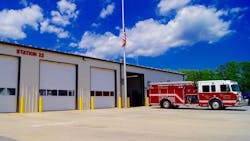Report: Small NC City Needs More FFs
By Dashiell Coleman
Source Gaston Gazette, Gastonia, N.C.
An outside agency is recommending that the town of Stanley hire more firefighters.
The small fire department is one of many across the state, including several in Gaston County, that’s facing a shortage of volunteer manpower.
Town Manager Heath Jenkins said the town is safe and that the department has made “huge strides” over the last few years, including transitioning from an all-volunteer department to one with mostly part-time paid staff and better equipment and training.
An assessment by Greenville, South Carolina-based Management Solutions for Emergency Services suggests the fire department needs to find more volunteers or hire more paid staff to make sure at least six firefighters respond to structure fires. Right now, according to the assessment, the town sends out an average of three firefighters on those calls — something that could put the department’s ISO rating in jeopardy.
It’s important to note, though, that Stanley’s mutual-aid agreements mean firefighters from surrounding departments will also respond to fires within the town. The assessment team also wrote that with a few changes, Stanley could actually improve its rating.
“You have very strong fire department records, training and other documentation, but that all does not matter if you don’t get your staffing issues figured out,” the assessment team wrote.
The fire department itself had requested the assessment as a way to get an outside viewpoint on how it would fare in a North Carolina Response Rating System inspection, which helps determine ISO ratings.
Such ratings range from Class 10 to Class 1, with Class 1 being the best. In general, the ratings are an indication of a department’s ability to prevent and fight fires. The ratings can also impact homeowners’ insurance premiums, with lower ratings leading to lower premiums.
Stanley’s current ISO rating is Class 5. Typically, only larger city departments with lots of resources, such as Charlotte Fire Department, have Class 1 ratings. Gastonia Fire Department has a Class 2 rating.
“If the Fire Department does everything listed in this report, the team from MSFES feels confident that you should achieve a Class 3 rating,” the assessment team wrote. “This would be a huge drawing factor for businesses in your town.”
Jenkins said the department’s budget has grown from around $120,000 several years ago to about $340,000 now. The town’s whole budget is about $6 million.
“I think that there are staffing concerns among the leadership in the fire department, and they’ve made those concerns known to the council, and the council has responded by providing additional hours and more staffing and man hours as they could afford to do so,” Jenkins said. “I’m not aware of any situation where the town has been placed in any type of danger or unsafe conditions.”
The highest paid staff member only makes about $27,000, and the cost of a single fire truck can run $500,000 or more — well over the entire department’s budget. Jenkins said the department works to get grant funding to offset as many costs as possible.
Right now, the Stanley Fire Department has roughly 24 firefighters, the majority of whom are part time and paid. During the day, there are paid part-time firefighters. At night though, the department switches to volunteer-only and there’s not necessarily anyone manning the station.
From 6 p.m. to 7 a.m., the department relies entirely on volunteers. That means there’s not necessarily anyone at the station if a fire happens overnight. Firefighters have to drive in to the station and get a truck before responding to a call.
Assistant Chief Michael Hullett said the department is “really hurting for people” when some volunteers are out of town or at their other jobs.
“It’s a common theme,” he said, mentioning how departments step in for each other when needed. “There are many days when we get phone calls from surrounding departments that they don’t have anybody and can we help answer their calls? We rely on them, too, for the same thing, so it’s a mutual relationship. It’s a big challenge.
"You always worry that something is going to happen and you’re not going to be able to answer the call, so to speak.”
The volunteer issue is being felt countywide. Gaston County Fire Marshal Eric Hendrix told The Gazette earlier this year that more than 700 firefighters in 26 departments provide coverage in the county, and that two-thirds of those firefighters are volunteers. Only the city of Gastonia’s fire department has a fully paid staff. Many agencies similar in size to Stanley use a similar mix of volunteer and part-time paid firefighters.
Training for volunteer firefighters is free, but firefighters need about 300 hours of training to get certified, plus about 30 hours a year in ongoing training.
The department is currently accepting applications for a part-time chief, and it plans to ask Town Council to fund more positions in the next fiscal year so that someone will be at the fire station 24 hours a day.
“I have full confidence in the fire staff that we have operating our organization, and we’ll continue to work together for the betterment of our community,” Jenkins said.
———
©2018 Gaston Gazette, Gastonia, N.C.
Visit Gaston Gazette, Gastonia, N.C. at www.gastongazette.com
Distributed by Tribune Content Agency, LLC.






